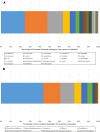Clinical Features and C-Reactive Protein as Predictors of Bacterial Exacerbations of COPD
- PMID: 33293804
- PMCID: PMC7718867
- DOI: 10.2147/COPD.S265674
Clinical Features and C-Reactive Protein as Predictors of Bacterial Exacerbations of COPD
Abstract
Introduction: Identifying predictors of bacterial and viral pathogens in sputum from patients with acute exacerbations of chronic obstructive pulmonary disease (COPD) may help direct management.
Methods: We used data from a trial evaluating a C-reactive protein (CRP) point of care guided approach to managing COPD exacerbations in primary care. We used regression analyses to identify baseline clinical features, including CRP value in those randomized to testing, associated with bacterial, viral or mixed infections, defined by the presence of bacterial and viral pathogens in sputum, detected by culture or polymerase chain reaction (PCR), respectively.
Results: Of 386 participants with baseline sputum samples, 79 (20.5%), 123 (31.9%), and 91 (23.6%) had bacterial, viral/atypical, and mixed bacterial/viral/atypical pathogens identified, respectively. Increasing sputum purulence assessed by color chart was associated with increased odds of finding bacterial and mixed (bacterial and viral/atypical) pathogens in sputum (area under the ROC curve (AUROC) for bacterial pathogens =0.739 (95% CI: 0.670, 0.808)). Elevated CRP was associated with increased odds of finding bacterial pathogens and mixed pathogens but did not significantly increase the AUROC for predicting bacterial pathogens over sputum color alone (AUROC for combination of sputum color and CRP = 0.776 (95% CI: 0.708, 0.843), p for comparison of models = 0.053). We found no association between the presence of sputum pathogens and other clinical or demographic features.
Conclusion: Sputum purulence was the best predictor of sputum bacterial pathogens and mixed bacterial viral/atypical pathogens in patients with COPD exacerbations in our study. Elevated CRP was associated with bacterial pathogens but did not add to the predictive value of sputum purulence.
Keywords: COPD; bacteria; exacerbation; infection; primary care; sputum.
© 2020 Francis et al.
Conflict of interest statement
Nick A Francis reports grants from NIHR HTA, during the conduct of the study. David Gillespie reports grants from the National Institute for Health Research, during the conduct of the study. Janine Bates reports grants from NIHR HTA, during the conduct of the study. Kerenza Hood report grants from NIHR HTA, during the conduct of the study; and I am a member of three NIHR funding committees: HTA General Committee, HTA Funding Committee Policy Group and the Research Professors panel. Christopher C Butler reports grants from the National Institute for Health Research Health Technology Assessment Programme, during the conduct of the study. The authors report no other potential conflicts of interest for this work.
Figures
Similar articles
-
Procalcitonin and C-reactive protein cannot differentiate bacterial or viral infection in COPD exacerbation requiring emergency department visits.Int J Chron Obstruct Pulmon Dis. 2015 Apr 13;10:767-74. doi: 10.2147/COPD.S76740. eCollection 2015. Int J Chron Obstruct Pulmon Dis. 2015. PMID: 25926728 Free PMC article.
-
C-reactive protein in outpatients with acute exacerbation of COPD: its relationship with microbial etiology and severity.Int J Chron Obstruct Pulmon Dis. 2016 Oct 21;11:2633-2640. doi: 10.2147/COPD.S117129. eCollection 2016. Int J Chron Obstruct Pulmon Dis. 2016. PMID: 27799762 Free PMC article.
-
Comparison of diagnostic values of procalcitonin, C-reactive protein and blood neutrophil/lymphocyte ratio levels in predicting bacterial infection in hospitalized patients with acute exacerbations of COPD.Wien Klin Wochenschr. 2015 Oct;127(19-20):756-63. doi: 10.1007/s00508-014-0690-6. Epub 2015 Jan 14. Wien Klin Wochenschr. 2015. PMID: 25586444
-
A Systematic Review and Meta-Analysis of Sputum Purulence to Predict Bacterial Infection in COPD Exacerbations.COPD. 2020 Jun;17(3):311-317. doi: 10.1080/15412555.2020.1766433. Epub 2020 May 27. COPD. 2020. PMID: 32456479
-
Biomarkers to guide the use of antibiotics for acute exacerbations of COPD (AECOPD): a systematic review and meta-analysis.BMC Pulm Med. 2022 May 13;22(1):194. doi: 10.1186/s12890-022-01958-4. BMC Pulm Med. 2022. PMID: 35549921 Free PMC article.
Cited by
-
Nebulised interferon beta-1a (SNG001) in the treatment of viral exacerbations of COPD.Respir Res. 2024 May 29;25(1):228. doi: 10.1186/s12931-024-02854-7. Respir Res. 2024. PMID: 38811970 Free PMC article. Clinical Trial.
-
Associations with Post-Consultation Health-Status in Primary Care Managed Acute Exacerbation of COPD.Int J Chron Obstruct Pulmon Dis. 2022 Feb 16;17:383-394. doi: 10.2147/COPD.S340710. eCollection 2022. Int J Chron Obstruct Pulmon Dis. 2022. PMID: 35210767 Free PMC article. Clinical Trial.
-
11β-HSD1 determines the extent of muscle atrophy in a model of acute exacerbation of COPD.Am J Physiol Lung Cell Mol Physiol. 2023 Apr 1;324(4):L400-L412. doi: 10.1152/ajplung.00009.2022. Epub 2023 Feb 21. Am J Physiol Lung Cell Mol Physiol. 2023. PMID: 36807882 Free PMC article.
-
Optimal cut-off value of serum procalcitonin in predicting bacterial infection induced acute exacerbation in chronic obstructive pulmonary disease: A prospective observational study.Chron Respir Dis. 2022 Jan-Dec;19:14799731221108516. doi: 10.1177/14799731221108516. Chron Respir Dis. 2022. PMID: 35830291 Free PMC article.
-
New methods to detect bacterial or viral infections in patients with chronic obstructive pulmonary disease.Expert Rev Respir Med. 2024 Sep;18(9):693-707. doi: 10.1080/17476348.2024.2396413. Epub 2024 Aug 29. Expert Rev Respir Med. 2024. PMID: 39175157 Review.
References
MeSH terms
Substances
LinkOut - more resources
Full Text Sources
Medical
Research Materials
Miscellaneous




